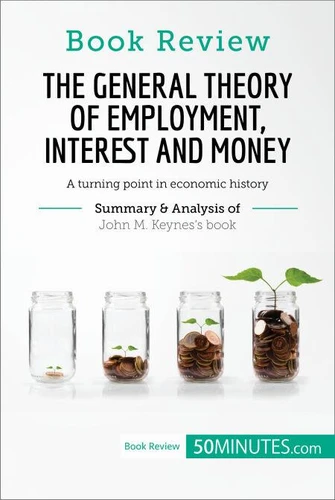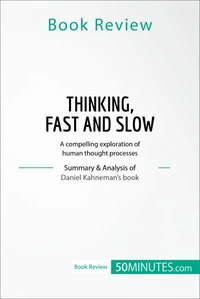Book Review
Book Review: The General Theory of Employment, Interest and Money by John M. Keynes. A turning point in economic history
Par : Formats :
Disponible dans votre compte client Decitre ou Furet du Nord dès validation de votre commande. Le format ePub est :
- Compatible avec une lecture sur My Vivlio (smartphone, tablette, ordinateur)
- Compatible avec une lecture sur liseuses Vivlio
- Pour les liseuses autres que Vivlio, vous devez utiliser le logiciel Adobe Digital Edition. Non compatible avec la lecture sur les liseuses Kindle, Remarkable et Sony
 , qui est-ce ?
, qui est-ce ?Notre partenaire de plateforme de lecture numérique où vous retrouverez l'ensemble de vos ebooks gratuitement
Pour en savoir plus sur nos ebooks, consultez notre aide en ligne ici
- FormatePub
- ISBN978-2-8080-0633-0
- EAN9782808006330
- Date de parution04/01/2018
- Protection num.pas de protection
- Infos supplémentairesepub
- Éditeur50Minutes.com
Résumé
It can be hard for busy professionals to find the time to read the latest books. Stay up to date in a fraction of the time with this concise guide. The General Theory of Employment, Interest and Money by John Maynard Keynes was first published in 1936, and had a lasting impact on both economic theory and state economic policies. Keynes's primary aim was to challenge certain aspects of classical economics which were accepted as fact at the time, namely Say's law, which states that supply will create its own demand, and the assumption that free markets automatically tend towards full employment.
Keynes introduced several revolutionary concepts in this book, including effective demand, the propensity to consume, the investment multiplier and the liquidity-preference, to support his arguments in favour of greater state interventionism as a response to financial crises. This book review and analysis is perfect for: .Anyone interested in the history of economic theory, particularly macroeconomics.Anyone who wants to understand the aims of state intervention in the financial market.Students of, or anyone interested in, modern politics and economicsAbout 50MINUTES.
COM| BOOK REVIEWThe Book Review series from the 50Minutes collection is aimed at anyone who is looking to learn from experts in their field without spending hours reading endless pages of information. Our reviews present a concise summary of the main points of each book, as well as providing context, different perspectives and concrete examples to illustrate the key concepts.
Keynes introduced several revolutionary concepts in this book, including effective demand, the propensity to consume, the investment multiplier and the liquidity-preference, to support his arguments in favour of greater state interventionism as a response to financial crises. This book review and analysis is perfect for: .Anyone interested in the history of economic theory, particularly macroeconomics.Anyone who wants to understand the aims of state intervention in the financial market.Students of, or anyone interested in, modern politics and economicsAbout 50MINUTES.
COM| BOOK REVIEWThe Book Review series from the 50Minutes collection is aimed at anyone who is looking to learn from experts in their field without spending hours reading endless pages of information. Our reviews present a concise summary of the main points of each book, as well as providing context, different perspectives and concrete examples to illustrate the key concepts.
It can be hard for busy professionals to find the time to read the latest books. Stay up to date in a fraction of the time with this concise guide. The General Theory of Employment, Interest and Money by John Maynard Keynes was first published in 1936, and had a lasting impact on both economic theory and state economic policies. Keynes's primary aim was to challenge certain aspects of classical economics which were accepted as fact at the time, namely Say's law, which states that supply will create its own demand, and the assumption that free markets automatically tend towards full employment.
Keynes introduced several revolutionary concepts in this book, including effective demand, the propensity to consume, the investment multiplier and the liquidity-preference, to support his arguments in favour of greater state interventionism as a response to financial crises. This book review and analysis is perfect for: .Anyone interested in the history of economic theory, particularly macroeconomics.Anyone who wants to understand the aims of state intervention in the financial market.Students of, or anyone interested in, modern politics and economicsAbout 50MINUTES.
COM| BOOK REVIEWThe Book Review series from the 50Minutes collection is aimed at anyone who is looking to learn from experts in their field without spending hours reading endless pages of information. Our reviews present a concise summary of the main points of each book, as well as providing context, different perspectives and concrete examples to illustrate the key concepts.
Keynes introduced several revolutionary concepts in this book, including effective demand, the propensity to consume, the investment multiplier and the liquidity-preference, to support his arguments in favour of greater state interventionism as a response to financial crises. This book review and analysis is perfect for: .Anyone interested in the history of economic theory, particularly macroeconomics.Anyone who wants to understand the aims of state intervention in the financial market.Students of, or anyone interested in, modern politics and economicsAbout 50MINUTES.
COM| BOOK REVIEWThe Book Review series from the 50Minutes collection is aimed at anyone who is looking to learn from experts in their field without spending hours reading endless pages of information. Our reviews present a concise summary of the main points of each book, as well as providing context, different perspectives and concrete examples to illustrate the key concepts.























